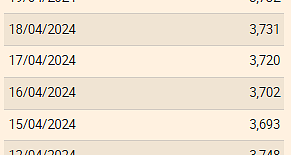the Prairie vole, the mountain Pipit, the poison dart frog (Ranitomeya imitator) and the cichlid (Xenotilapia spiloptera) are So different, therefore, they resemble in behaviour: they are monogamous. Now, U.S. researchers have looked at the males in the brain, and Amazing to be discovered. The Team has tried using two regions of the brain of this vertebrate animals, to unravel the mystery of monogamy.
The studied animal groups – developed mammals, birds, amphibians and fish – have before many millions of years independently of each other. And some of their species to be monogamous. This Form of living together is a multi-arose in Evolution. It is surprising, therefore, that always appeared to be very similar groups of genes in the studied monogamous animal species in the brain are active. It is "24 to 150 genes," says Rebecca Young of the University of Texas in Austin, who performed together with Hans Hofmann and colleagues, the study and the results in the journal "PNAS" published.
It could be these groups of genes, which represent the different behaviour of monogamous to polygamous. So living males are usually monogamous, less aggressive towards the females, defend their territory, but more aggressive and they are more involved in the rearing of the young. For example, the males of the in Peru, domestic of the arrow to help poison frogs, the contract only with a female mate, her partner, the young major. Drag the tadpoles on her back. In the case of a polygamous closely related species, the strawberry frog (Oophaga pumilio), bear the females, the main burden of care for the brood.
Prairie voles cuddling and a life-long faithful
The population geneticist Gerald Heckel, University of Bern, the study "out of place neat interesting". The U.S. researchers have introduced a completely new approach, by comparing the genes of different animal groups. Heckel disturbs, however, the term "monogamy". Including not just understand the life-long Loyalty. "The man is typically considered to be monogamous," says the researcher. People often have multiple relationships – usually one after the other. It would be better to talk of "pair-bonding".
"Depending on the species, monogamy may be pronounced differently," says Dieter Lukas of the Max-Planck-Institute for Evolutionary anthropology in Leipzig, Germany. Luke assumes that there are different stages of how monogamous relationships can develop. The monogamy is limited, for example, in the case of the African dwarf antelope, the Dik-Diks, the fact that the male secures the female. "If the female is signaled by his urine, that it is ready to conceive, then the male about peeing," says Luke. Competitors have no Chance to sniff out the mating-ready females. Further, the "love not", though.
Much closer to the plains are connected, however, voles. You apply as a Prime example, in behavioral research for a loyal and life-long partnership – in the case of a two-year life expectancy. Other than for the purpose of community of the Dik-Diks the Prairie cuddle namely voles often with each other.
page jumps, there are also animals
Generally speaking, monogamy is found in most animal groups only sporadically. In amphibians and fish is more of a rarity, and of the mammals only live for a maximum of five per cent, in stable couple relationships. However, Monogamy is more than 90 percent of the bird species are the rule. Why not benefit from some of the animal species of a stable partnership, and others? This had something to do with the environment and resources, says the Bernese researchers Heckel.
The only purpose of education is, as many of the Young raising. Birds need extensive territories, which provide the necessary food. In addition, both the Breed and the feeding of the Chicks is distribute easy for you to both partners. In mammals, however, the females carry the young in the belly and provides you with milk.
monogamy is worth it, but also for mammals, if the resources are scarce. An example of this is in Southeast Asia, native Gibbons. The primates to be monogamous in a tight Group cohesion. The only way you can make use of the sparse food optimally. Food is abundant, can afford the male a Harem, such as the lion.
strawberry frog (Oophago pumilio): He lives a polygamist. The females take care of almost alone to the rearing of the Qaulquappen. Photo: Keystone
And the man? The origin of monogamy could be the Homo sapiens unique, mutmassten Frans de Waal of Emory University in Atlanta, and Sergey Gavrilets of the University of Tennessee in Knoxville a few years ago in the journal "PNAS". Is possible that in the case of human monogamy, instead of genetic, rather cultural factors of the shutter. One idea is that long-lasting relationships in a society of men equal and so the cooperation in the group promotes.
you Could also discover in the human brain, a similar Range as in the case of monogamous species, which have examined the U.S. researchers? "That is quite possible," says Hans Hofmann. You would have to examine human brain samples and with those of chimpanzees who live polygamous, compare. But monogamy is not identical with Loyalty, stressed Hofmann. Also in the case of animals page jumps.
(Sunday newspaper)
Created: 20.01.2019, 09:51 PM

 The Euribor today remains at 3.734%
The Euribor today remains at 3.734% Germany: the trial of an AfD leader, accused of chanting a Nazi slogan, resumes this Tuesday
Germany: the trial of an AfD leader, accused of chanting a Nazi slogan, resumes this Tuesday New York: at Columbia University, the anti-Semitic drift of pro-Palestinian demonstrations
New York: at Columbia University, the anti-Semitic drift of pro-Palestinian demonstrations What is Akila, the mission in which the Charles de Gaulle is participating under NATO command?
What is Akila, the mission in which the Charles de Gaulle is participating under NATO command? What High Blood Pressure Does to Your Body (And Why It Should Be Treated)
What High Blood Pressure Does to Your Body (And Why It Should Be Treated) Vaccination in France has progressed in 2023, rejoices Public Health France
Vaccination in France has progressed in 2023, rejoices Public Health France Food additives suspected of promoting cardiovascular diseases
Food additives suspected of promoting cardiovascular diseases “Even morphine doesn’t work”: Léane, 17, victim of the adverse effects of an antibiotic
“Even morphine doesn’t work”: Léane, 17, victim of the adverse effects of an antibiotic MEPs validate reform of EU budgetary rules
MEPs validate reform of EU budgetary rules “Public Transport Paris 2024”, the application for Olympic Games spectators, is available
“Public Transport Paris 2024”, the application for Olympic Games spectators, is available Spotify goes green in the first quarter and sees its number of paying subscribers increase
Spotify goes green in the first quarter and sees its number of paying subscribers increase Xavier Niel finalizes the sale of his shares in the Le Monde group to an independent fund
Xavier Niel finalizes the sale of his shares in the Le Monde group to an independent fund Owner of Blondie and Shakira catalogs in favor of $1.5 billion offer
Owner of Blondie and Shakira catalogs in favor of $1.5 billion offer Cher et Ozzy Osbourne rejoignent le Rock and Roll Hall of Fame
Cher et Ozzy Osbourne rejoignent le Rock and Roll Hall of Fame Three months before the Olympic Games, festivals and concert halls fear paying the price
Three months before the Olympic Games, festivals and concert halls fear paying the price With Brigitte Macron, Aya Nakamura sows new clues about her participation in the Olympics
With Brigitte Macron, Aya Nakamura sows new clues about her participation in the Olympics Skoda Kodiaq 2024: a 'beast' plug-in hybrid SUV
Skoda Kodiaq 2024: a 'beast' plug-in hybrid SUV Tesla launches a new Model Y with 600 km of autonomy at a "more accessible price"
Tesla launches a new Model Y with 600 km of autonomy at a "more accessible price" The 10 best-selling cars in March 2024 in Spain: sales fall due to Easter
The 10 best-selling cars in March 2024 in Spain: sales fall due to Easter A private jet company buys more than 100 flying cars
A private jet company buys more than 100 flying cars This is how housing prices have changed in Spain in the last decade
This is how housing prices have changed in Spain in the last decade The home mortgage firm drops 10% in January and interest soars to 3.46%
The home mortgage firm drops 10% in January and interest soars to 3.46% The jewel of the Rocío de Nagüeles urbanization: a dream villa in Marbella
The jewel of the Rocío de Nagüeles urbanization: a dream villa in Marbella Rental prices grow by 7.3% in February: where does it go up and where does it go down?
Rental prices grow by 7.3% in February: where does it go up and where does it go down? Europeans: “All those who claim that we don’t need Europe are liars”, criticizes Bayrou
Europeans: “All those who claim that we don’t need Europe are liars”, criticizes Bayrou With the promise of a “real burst of authority”, Gabriel Attal provokes the ire of the opposition
With the promise of a “real burst of authority”, Gabriel Attal provokes the ire of the opposition Europeans: the schedule of debates to follow between now and June 9
Europeans: the schedule of debates to follow between now and June 9 Europeans: “In France, there is a left and there is a right,” assures Bellamy
Europeans: “In France, there is a left and there is a right,” assures Bellamy These French cities that will boycott the World Cup in Qatar
These French cities that will boycott the World Cup in Qatar Serie A: Bologna surprises AS Rome in the race for the C1
Serie A: Bologna surprises AS Rome in the race for the C1 Serie A: Marcus Thuram king of Italy, end of the debate for the position of number 9 with the Blues?
Serie A: Marcus Thuram king of Italy, end of the debate for the position of number 9 with the Blues? Milan AC-Inter Milan: Thuram and Pavard impeccable, Hernandez helpless… The tops and flops of the derby
Milan AC-Inter Milan: Thuram and Pavard impeccable, Hernandez helpless… The tops and flops of the derby Ligue 2: Auxerre leader, Bordeaux in crisis, play-offs... 5 questions about an exciting end of the season
Ligue 2: Auxerre leader, Bordeaux in crisis, play-offs... 5 questions about an exciting end of the season


















